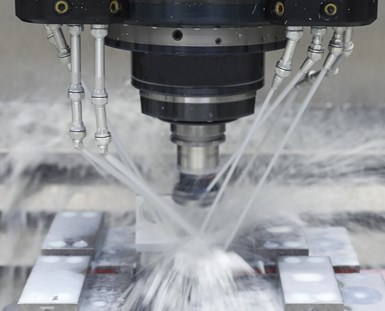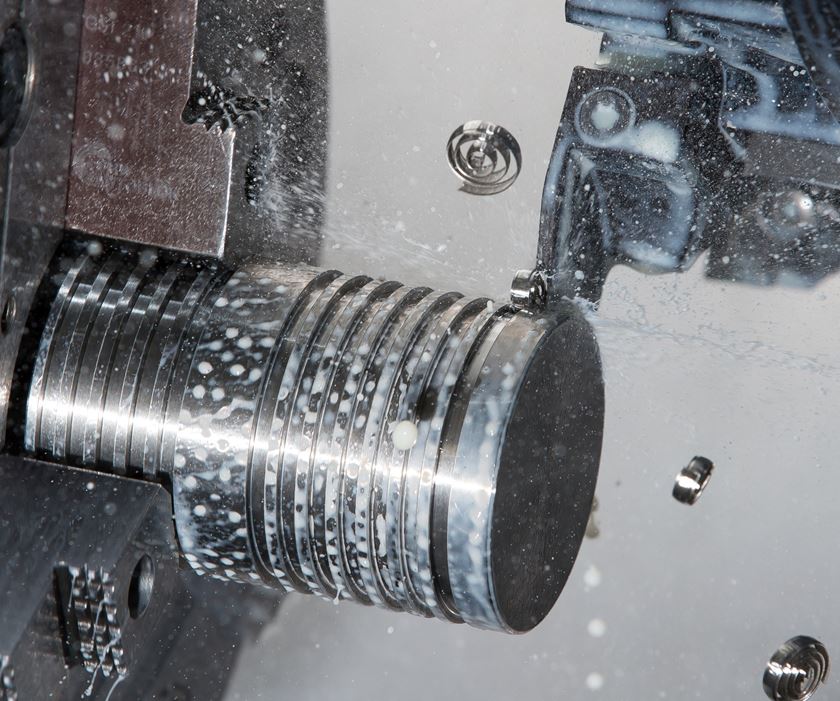Finding the most compatiblemetalworking fluidfor a specific application as well as understanding how to maintain the coolant to get the best performance from it takes time and patience. Fluids need to perform three duties: lubricate the cutting edge; help move heat away from the cutting edge; and flush chips from the cutting edge. If the fluid is not living up to these expectations, it is time to choose a new coolant/oil or perform maintenance on the fluid already in place.
To simplify the selection and maintenance process, the following six guidelines are especially useful to understand. For the lubricant selection process, a trusted coolant distributor can be an asset.
Featured Content
1. Machine requirements.Water-miscible coolant and neat oil are the two main fluids available for machine tools. Swiss-type lathes usually run better with a neat oil, and most CNC mills and lathes require a water-miscible product.
For the neat oil’s base fluid, a mineral oil base, ester (vegetable) oil base, or a newer gas-to-oil base are the options. Although mineral oil bases can be very effective, ester oil bases can offer better part finish and a higher flashpoint. The gas-to-oil products are especially good at releasing entrained air (foam). Therefore, it is necessary to consider the most common diameters that the machine tool will be cutting to figure out which viscosity is appropriate. The smaller the diameter, the lower the viscosity should be, otherwise increased rpms will fling the oil off the workpiece.
2. Shop preference.Whether a new machine is ready to be filled or the product already in use is not performing to the highest standards, every machine shop needs to find the coolant or oil that is best for them. Unfortunately, there is no “unicorn” fluid. Discovering the right fluid that checks all the boxes is a process. Is it the least expensive fluid you are after or is it the most stable fluid? Do you want the safest lubricant? If you are looking to switch products, what is the current issue that you are trying to change? Too much foaming? Operator skin issues? Better tool life?
Metalworking fluids need to perform three duties: lubricate the cutting edge; help move heat away from the cutting edge; and flush chips from the cutting edge.
Photo Credits: Blaser Swisslube
3. Operations and water quality.It is critical to know what operations the machine tool will be running as well as the water quality being used for a water-miscible fluid.
Depending on the EP (extra pressure) additive package in the fluid’s concentrate, one fluid might be better for tapping small holes, one better for stability and one might perform better when cutting only titanium, for example.
水的质量是申请窟er-miscible product is critical to identify as well. For instance, using water from a well that produces high chloride or sulfur content may cause issues with the coolant or with the surface of the machined parts themselves. If using very soft water, however, foaming might become a problem. So, if a machine has a high-pressure coolant system and it is applying soft water, using a coolant with very good nonfoaming characteristics is crucial.
4. Materials being machined.The materials being cut matter when it comes to identifying the proper metalworking fluid to use.For example, if machining all magnesium parts, a coolant designed for that application should be applied. For Inconel, a more robust coolant with a better EP package is necessary. If an application is running aluminum, steel and stainless, and does not necessarily need the performance of the coolant designed for nickel alloys, then a local distributor can give advice.
5. Contamination.Contamination can occur in both types of oils.For neat oils, the enemy is oxidation and excessive heat. Oxidation can occur from contamination, excessive heat or foaming. Neat oils normally have an anti-oxidizing additive in it, but once that additive is depleted, the oil degrades quickly.
Tramp oils cannot be separated from neat oil, so measures must be taken to repair any leaks in the system. Tramp oils change the viscosity of the oil, which leads to issues at the cutting edge.
If the oil filter is not doing its job, fine chips can contaminate the oil and then be circulated through the system. This can cause coolant-through tools to clog. As a result, finish marks on the machined part can occur. For neat oils, a filter with a rating of 5 microns is recommended.
If the oil filter is not doing its job, fine chips can contaminate the oil and then be circulated through the system. This can cause coolant-through tools to clog.
Neat oils can also be some of the worst offenders for causing mist, so a quality, properly sized mist collector is a must.
For water-miscible coolants, concentration and contamination must be monitored to ensure a coolant performs its duty with a long sump life.
6. Concentration.A refractometer is the only way to measure concentration. Operators should be trained to calibrate and read a refractometer. A chart on the machine can verify weekly concentration checks. The concentration should be read at the nozzle spraying at the cutting edge for the most accurate check. Most water-miscible products running in a CNC mill or lathe are between 5 and 15%.
Helpful coolant distributors and coolant manufacturer representatives visit machine shops to do spot checks for concentration, pH and water hardness.Blaser Swisslube, for example, offers what it calls, “Services in the Drum,” where a distributor visits a shop to do just that and send samples to a lab for further analysis, if needed.
折射计也可以读重污染。The line in the refractometer should be clean and crisp. But if it appears fuzzy or out of focus, it is a sign excessive contamination may be present. Using a belt skimmer or a wheel skimmer is one way to fix the issue. Implementing a coalescer that enables the tramp oil to rise and process the clean coolant back to the sump is another way to address the problem. If the machine is not running, the tramp oils rise to the top, which can then be vacuumed off with a wet vacuum.
At the point that the coolant mixes with water is another time to optimize coolant performance. The best mixers force the concentrate to mix with water, as opposed to only proportioning the two together. The concentration of the coolant is different from charging a new sump compared to topping off the sump after the volume goes down a little.
Read: United Grinding Event Unveils C.O.R.E. Control Platform
Like with neat oils, water-miscible fluids can be filtered when fines become an issue. Whereas the neat oil should be filtered around 5 microns, water-miscible products usually require a 15-micron level filter.
Coolant selection and maintenance is a process. Taking the time to consider the factors can lead to using a product that suits the processes.
About the Author
Josh Robinette has been selling coolant, oil and cutting tools for almost eight years. Robinette began his career as a machinist for 10 years prior to his current position atCutting Tool Control, a distributor in Seattle, Washington. Blaser Swisslube is the brand of metalworking fluids he sells.
RELATED CONTENT
Setup Options for Swiss Automatic Lathes
A hydraulic chuck and a counter-balanced centering tool, originally developed as in-house solutions, are now available to address the limited working space that is common in Swiss machining.
A New Approach to CNC Turning
This turning process takes advantage of a turn-mill’s B-axis spindle to vary a tool’s approach angle to optimize chip control and feed rates.
3 Threading Options for Holemaking
Thorough analysis before selecting and committing to tooling will produce quality holemaking in the most efficient and cost-effective way. Here's a look at three ways to cut threads.

















